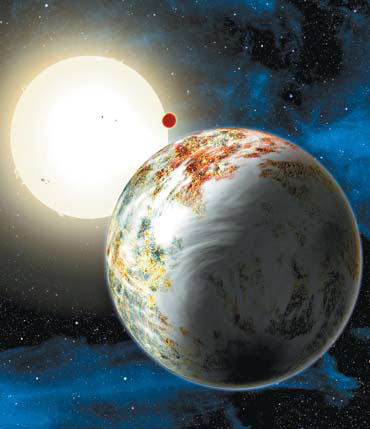Super-sized rocky planet found beyond solar system
By Irene Klotz in Boston (China Daily) Updated: 2014-06-04 06:51Major discovery changes way scientists think of mega-Earths
|
The newly discovered planet Kepler-10c dominates the foreground in this artist's rendering. Its sibling, Kepler-10b, is in the background. Both orbit a sunlike star. Provided to China Daily |
Astronomers have discovered a new type of rocky planet beyond the solar system that weighs more than 17 times as much as Earth while being just over twice the size, scientists said on Monday.
This so-called mega-Earth circles a very old star called Kepler-10, which is about 560 light-years away from Earth in the constellation Draco.
The discovery, announced at the American Astronomical Society meeting in Boston, was a surprise since planets that large were believed to be mostly gas, not solid rocky bodies like Earth or Mars, said physicist Dimitar Sasselov, director of the Harvard Origins of Life Initiative.
Scientists do not yet understand how the planet, known as Kepler-10c, formed. It has a diameter of about 29,000 km, 2.3 times greater than Earth's.
"A mega-Earth is a lot of solids concentrated in the same place without any gas. That is a problem because our understanding for how planets form requires the solids to get together in an environment where almost 99 percent of the mass ... is hydrogen and helium," Sasselov said at a news conference.
Smaller solid bodies, like Earth or Mars, believed to form from leftover materials, take less time to do so. With a longer incubation time, large planets should gather up huge amounts of gas in the process - or so scientists thought.
However mega-Earths formed, the discovery of another type of rocky world bodes well in the search for life beyond Earth, Sasselov said.
"As far as we know - and we know very little about origins of life - we think the emergence of life from geochemistry" occurs on solid planets, Sasselov said.
Related research shows that about 75 percent of the planets found with NASA's Kepler space telescope are less than four times Earth's diameter.
In the solar system, there is nothing between the size of Earth, the largest rocky planet, and Neptune, the smallest gas giant with a diameter nearly four times Earth's.
Astronomer Lars Buchhave, of the Harvard-Smithsonian Center for Astrophysics, told reporters: "We really want to know about these planets. Are they rocky planets with a thin, compact atmosphere like Earth, or are they rocky cores with some sort of extended hydrogen-helium envelope and where there is really no surface?"
Reuters











